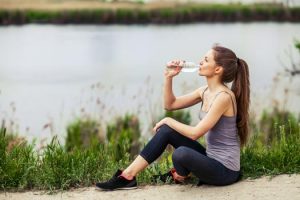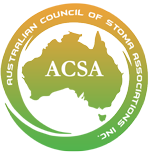The summer months are here and, whilst it is a great time of year with lots of fun, frivolity and relaxation, there are also some important considerations
for Ostomates in staying healthy during this time. And one of them is to remain hydrated during the warmer weather. Hydration is very important for Ostomates, muchmore so than for the average person. This is due to the fact that part of their intestine has been removedand intestinal function is compromised. Three main factors will infl uence the degree to which fluid balance is affected in an individual Ostomate – the part of the bowel that has been removed, and the quantity and consistency of output.Different parts of the gastrointestinal tract perform different functions, with the small intestine mainly digesting and absorbing nutrients from the foods that are eaten, and the large intestine mainly absorbing water and electrolytes back into the body.
Therefore, for Colostomates who have only had a small part of the large intestine removed, their ability to absorb water may not have been affected very much and they may not need to compensate for reduced fluid absorption.
However, for an Ileostomate who has had all of their large bowel removed and perhaps some of the small intestine too, the need for additional fluids is greater. Over time, the small intestine will begin to compensate for the functions of the large intestine, but it takes time for this adaptation to occur.
The requirement for extra fluid is also affected by the nature of the stomal output. If it is very liquid and resembles water, then it is imperative to replenish this fluid loss.
However, if the output has a thicker consistency and is more like a paste, then less fluid is lost from the body and the need to replace it is not as dire. In a person with full intestinal function (i.e. no surgery), approximately 2.5 liters of fluid are lost from the body each day via the lungs (breathing), the skin(sweating), the kidneys (urination) and the intestines. Of this 2.5 liters, only 100 milliliters is usually lost via the intestines.

 However, for an Ostomate, the amount of fluid lost from the intestine can be far greater,depending on the consistency and quantity of the output. Therefore, in a person who has had stomal surgery and has a liquid output, this quantity could be much higher. Fluid intake is usually via both moist foods
However, for an Ostomate, the amount of fluid lost from the intestine can be far greater,depending on the consistency and quantity of the output. Therefore, in a person who has had stomal surgery and has a liquid output, this quantity could be much higher. Fluid intake is usually via both moist foods
(approximately 700 millilitres) and ingested liquids (usually approximately 1,600 milliliters per day), with around 200 millilitres of fluid being produced within the body itself via metabolic processes.
Therefore fluid intake usually totals approximately 2.5 litres per day, which would normally keep a person in positive fluid balance. However, as previously mentioned, if the output from the gastrointestinal tract is higher than 100 millilitres, which is often the case for an Ostomate and for an Ileostomate in particular, then fluid intake needs to be much higher than this.
The first step for an Ostomate in assessing fluid balance is to determine their level of output. This can easily be done by noting the number of times the bag is emptied per day estimating how many milliliters were in the bag each time (if the output is purely fluid). Multiplying the two figures over a whole day will give a rough estimation of output. It is then important to make sure this figure is at least exceeded, if not doubled, throughout the day to replenish fl uid loss. But, apart from assessing fluid balance, how else can you tell if you are dehydrated?
Some of the most common symptoms are dry mouth,headaches, irritability, fatigue, poor concentration,constipation and dry skin. Low blood pressure and fainting spells can also be indicative that fluid levels in the body are low.
An important fact to be aware of in maintaining hydration levels is that the thirst mechanism becomes less reliable as we age. By this I mean that the sensation of thirst starts to weaken, and it isn’t triggered as often as it used to be. Therefore, as we get older, it is important not to rely on the sensation of thirst to tell us when to drink. A more useful tool can be to use a visual reminder to drink fluid. For me, this takes the form of a jug on my desk or kitchen bench that I fill up each morning, and I have set the rule that it must be emptied by lunchtime and again when I finish work, or late afternoon. That way I know I am drinking at least twoliters of fluid every day.Using drink bottles can also help to provide a visual reminder to drink fluid, as well as providing a measuring tool for knowing how much fluid has been consumed. However, a note of caution – don’t consume fluid from a plastic drink bottle that has been left sitting in the sun or in the car during summer. If the bottle has heated up, there is a risk that chemicals from the plastic bottle may have leached into the fluid in the bottle. These chemicals may be hazardous to your health. During the summer months it can be safer to drink from glass or metal containers if possible. When it comes to fluid replenishment, it is also important for Ileostomates especially to sip water and not gulp in large quantities. If large quantities of water are drunk rapidly, they have a tendency to leave the body as fast as they entered! Another important consideration in fluid balance is that excessive amounts of fluids such as alcohol, tea and coffee may not be hydrating and fluid replenishing, but may actually be dehydrating and fluid depleting. Alcohol is a potent diuretic and will increase fluid loss from the body. Caffeine is a more moderate diuretic. Approximately one mililiter of fluid is lost for every one milligram of caffeine consumed. A 250 milliliter cup of instant coffee that contains approximately 80 milligrams of caffeine is therefore mainly hydrating. However, a short black espresso in a tiny cup contains much more caffeine and much less water so is more dehydrating. Tea contains less caffeine than coffee. The quantities of each of these that are consumed on a daily basis can therefore have a considerable effect on your fluid balance. Therefore, when it comes to replacing fluid in the body, water is best. For those who are not fond of the taste of water, adding some fresh lime or lemon juice, or a dash of apple, orange or pineapple juice can improve the taste. This can also help with absorption. Switching to herbal teas can also help to rehydrate the body. If having to get up to go to the toilet during the night is a problem, drink more fluid earlier in the day and less after 3.00 pm.
Fluid intake can also be boosted by eating watery foods such as watermelon, mango, juicy peaches and nectarines, and grapes. Just be aware that they may also loosen stools and therefore increase output, so keep the quantity moderate. Milk drinks and soups can also add to the total fluid intake for the day. from the chemist might be more appropriate. But be mindful that due to the sodium content of these beverages, caution needs to be taken by those on a low sodium diet. In relation to hydration, an Ileostomate recently made a very valid comment as we were talking on this subject. She said, “It is not on the hot days over 30°C when you are at greater risk of dehydration, because you are conscious of consuming more fluid on those days. It is when the temperature is between 25°C and 30°C that you are more likely to forget to drink extra fluid.” And she is right! Many years of experience have taught her that. So my advice during the warmer weather is to drink up! Let’s all Toast to a positive fluid balance during summer and better health for everyone!
For more articles about hydration and nutrition for ostomates, see nutritionforostomates.com.au

“Source: (Ostomy Australia Magazine) Margaret Allan is a qualified Nutritionist who advises Ostomates and the general public on diet and health-related matters. Margaret has a range of consulting options available and can be contacted via www.nutritionforostomates.com.au or email [email protected]“
